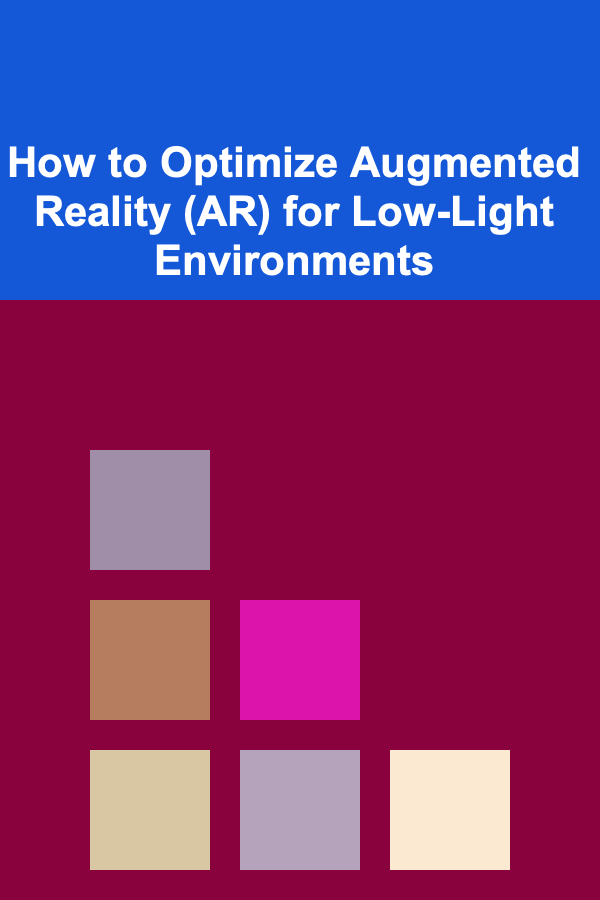
How to Optimize Augmented Reality (AR) for Low-Light Environments
ebook include PDF & Audio bundle (Micro Guide)
$12.99$8.99
Limited Time Offer! Order within the next:

Augmented Reality (AR) has made significant strides in various industries, ranging from entertainment and gaming to healthcare, education, and retail. However, one of the key challenges AR technologies face is performance optimization in low-light environments. In low-light conditions, the effectiveness of AR applications can be significantly reduced, leading to poor user experiences. This article delves into the problem of low-light AR and explores practical solutions to optimize AR for such conditions. It will discuss the underlying issues, techniques, and tools for enhancing AR performance in low-light scenarios.
Introduction
Augmented Reality (AR) is a technology that blends digital information with the physical world, allowing users to interact with both in real time. AR applications typically rely on sensors, cameras, and software to track real-world objects and overlay digital content. However, for AR to function correctly, the environment needs to provide adequate lighting for the system's sensors and cameras to work effectively.
Low-light conditions pose a significant challenge because insufficient lighting can reduce the accuracy of depth perception, object recognition, and motion tracking. As AR technology becomes more integrated into everyday devices like smartphones, tablets, and smart glasses, optimizing AR for low-light environments is crucial for ensuring a seamless and immersive experience for users.
This article will explore several strategies and technologies that can help address the issue of AR performance in low-light environments, ensuring that AR can function reliably and efficiently across all lighting conditions.
Understanding the Challenges of Low-Light Environments
Before diving into optimization strategies, it is essential to understand the core challenges AR faces in low-light environments. The performance of AR systems is primarily dependent on visual data captured by cameras and sensors. When lighting is insufficient, these systems struggle to capture clear and accurate images, which compromises the functionality of the AR application.
1. Depth Perception Issues
AR systems rely heavily on depth perception to place virtual objects in the correct position in relation to the real world. Depth-sensing technologies, such as stereo cameras, LiDAR, or structured light, are used to estimate the distance between objects. In low-light environments, these systems often struggle to capture accurate depth information, leading to virtual objects that appear misaligned or float unnaturally within the scene.
2. Reduced Object Detection and Recognition
In AR applications, object recognition is essential for tracking physical objects and aligning digital content with them. Low light can make it difficult for AR systems to detect and recognize objects, as cameras are unable to pick up enough contrast or details. This often results in tracking failures, where the AR system loses the real-world object it is supposed to overlay content onto.
3. Motion Tracking Failures
Another critical component of AR is motion tracking, which helps maintain the stability of virtual objects as the user moves through space. In low-light environments, motion tracking systems often become less accurate because sensors rely on visual cues, which are difficult to capture in poor lighting conditions. As a result, the user may experience lag, jitter, or displacement of digital content.
4. Noise and Image Distortion
Low-light conditions often introduce visual noise, which degrades image quality. Cameras typically boost their sensitivity to light in dark environments, but this process can introduce noise, which distorts the image and makes it difficult for AR systems to identify objects, track motion, and create accurate depth maps. Additionally, images in low-light environments often suffer from color distortion, leading to incorrect rendering of digital content.
Techniques to Optimize AR for Low-Light Environments
To address these challenges, several techniques and approaches can be employed to optimize AR for low-light conditions. These solutions focus on improving image quality, enhancing depth perception, and ensuring accurate object detection, all while maintaining real-time performance.
1. Improved Camera Sensitivity and Low-Light Enhancement Algorithms
One of the most fundamental ways to enhance AR performance in low-light conditions is to improve the camera's sensitivity to light. Modern AR systems often use cameras with high-quality sensors that are designed to perform well in low-light environments. These cameras can capture more light by increasing the sensor's exposure time, allowing them to gather more information in darker settings.
In addition to hardware improvements, software algorithms can be used to enhance low-light images. For example, noise reduction algorithms, like those based on deep learning, can be used to minimize image distortion caused by low light. These algorithms can identify patterns in low-light images and remove unwanted noise, improving the clarity of the image.
2. Active Lighting Systems
Active lighting systems are a popular solution for low-light AR environments. These systems use infrared (IR) light or other non-visible light sources to illuminate the scene without affecting the user's experience. IR lighting does not interfere with the visible environment and is invisible to the human eye, but it allows the camera and sensors to capture the necessary data for AR applications.
Many AR headsets, such as Microsoft's HoloLens, incorporate active lighting technologies to ensure that their depth sensors can accurately perceive the surroundings, even in complete darkness. By using IR or LED lights that project patterns or emit light, AR systems can obtain the data they need to track objects and environments accurately.
3. Depth-Sensing Technologies
To ensure accurate depth perception, AR systems can utilize advanced depth-sensing technologies, such as LiDAR, structured light, and time-of-flight (ToF) cameras. These sensors work by emitting light pulses and measuring the time it takes for the light to return, providing accurate depth information even in low-light environments.
LiDAR, in particular, has gained popularity in mobile AR applications, with recent smartphones, such as the iPhone 12 and later models, incorporating LiDAR sensors. This technology is highly effective in low-light conditions because it uses laser light, which is not dependent on visible light sources. As a result, it can generate depth maps that allow AR applications to create precise 3D models and align virtual objects in the real world, even in dark settings.
4. Simultaneous Localization and Mapping (SLAM) Enhancements
SLAM is a critical technique used in AR to map the environment and track the user's movement in real time. SLAM algorithms help the AR system understand the spatial relationships between virtual and real objects, allowing for accurate placement and interaction.
To optimize SLAM for low-light environments, improvements can be made in feature extraction and tracking algorithms. These algorithms identify distinct visual features, such as edges or corners, which the system uses to create a map of the environment. In low-light conditions, SLAM algorithms can rely more on depth data, such as those provided by LiDAR sensors, and less on visual features. This reduces the reliance on the quality of images captured by cameras in low-light conditions.
5. Hybrid AR Systems: Combining Vision and Inertial Sensors
Hybrid AR systems use a combination of visual sensors (cameras, depth sensors) and inertial sensors (accelerometers, gyroscopes) to improve performance in low-light environments. Inertial sensors can track the motion and orientation of the device, providing supplementary information to the visual sensors.
For instance, when the camera cannot capture enough information due to low lighting, the inertial sensors can help maintain the stability and tracking of virtual objects. This technique is often used in mobile AR applications, where the camera may struggle in low-light settings, but the device's internal sensors can still provide reliable motion tracking.
6. Machine Learning for Real-Time Image Processing
Machine learning models, particularly those based on neural networks, can be trained to enhance AR performance in low-light conditions. These models can be used for real-time image enhancement, object recognition, and motion tracking. By training on large datasets of low-light images, machine learning algorithms can learn to better predict the features of objects and improve tracking accuracy.
For example, deep learning techniques can be used to create more robust object recognition algorithms that perform well in low-light environments. These models can identify key features of objects even when lighting conditions are poor, improving the overall accuracy and reliability of AR applications.
7. User Behavior and Interaction Adaptations
Sometimes, the issue of low-light performance can be mitigated by modifying user behavior or interactions. For example, AR systems can be designed to alert users when lighting conditions are too poor for optimal performance, providing suggestions such as moving to a better-lit area or activating a flashlight. Additionally, users can be prompted to hold the device more steadily or at different angles to improve tracking accuracy in low-light settings.
Conclusion
Optimizing AR for low-light environments is essential for ensuring a consistent and immersive user experience. By addressing challenges related to depth perception, object detection, motion tracking, and noise reduction, AR technologies can function reliably across a range of lighting conditions. Solutions such as enhanced camera sensitivity, active lighting systems, depth-sensing technologies, and machine learning algorithms can significantly improve AR performance in dark environments.
As AR continues to evolve and become more integrated into various industries, optimizing it for low-light conditions will remain a key focus for developers. By combining innovative hardware, advanced software, and user-centered design, AR can be made more accessible and effective, even in the most challenging lighting scenarios.

How to Profit from Raising P Pigs: A Complete Guide for Beginners
Read More
How to Store Seasonal Items Without Taking Up Too Much Room
Read MoreHow To Use Acoustic Tracking for Marine Animals
Read More
How To Understand Facial Recognition Technology and Privacy
Read More
How To Simplify Your Social Calendar
Read More
How to Track Life Insurance Expenses with Mobile Apps
Read MoreOther Products

How to Profit from Raising P Pigs: A Complete Guide for Beginners
Read More
How to Store Seasonal Items Without Taking Up Too Much Room
Read MoreHow To Use Acoustic Tracking for Marine Animals
Read More
How To Understand Facial Recognition Technology and Privacy
Read More
How To Simplify Your Social Calendar
Read More